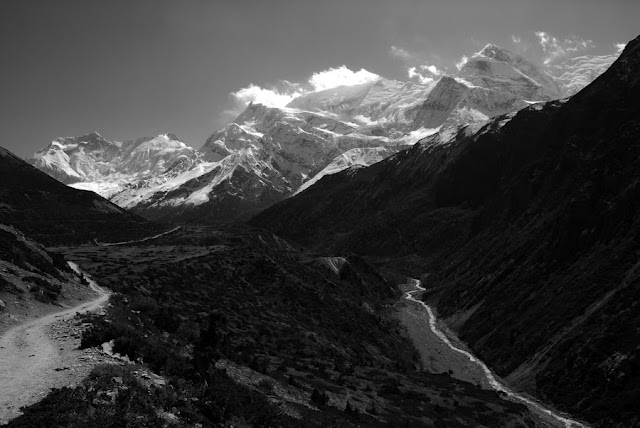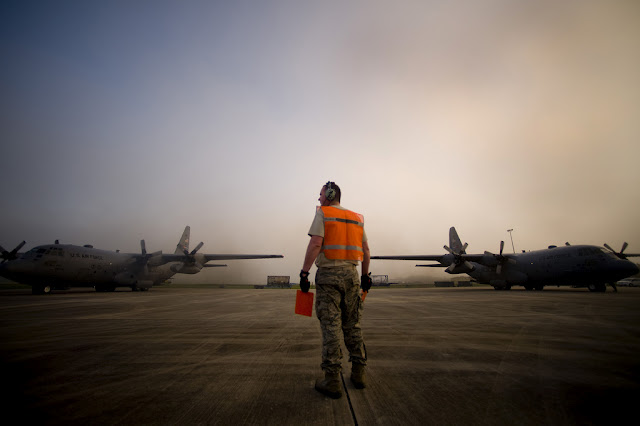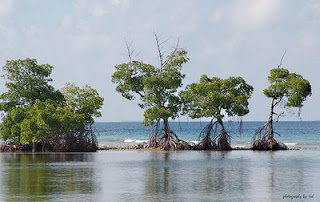-
Rear Admiral Morisetti Launches the UK’s “4 Degree Map” on Google Earth
›Having had such success with the original “4 Degree Map” that the United Kingdom launched last October, my colleagues in the UK Foreign and Commonwealth Office have been working on a Google Earth version, which users can now download from the Foreign Office website.
This interactive map shows some of the possible impacts of a global temperature rise of 4 degrees Celsius (7° F). It underlines why the UK government and other countries believe we must keep global warming to below 2 degrees Celsius, compared to pre-industrial times; beyond that, the impacts will be increasingly disruptive to our global prosperity and security.
In my role as the UK’s Climate and Energy Security Envoy I have spoken to many colleagues in the international defense and security community about the threat climate change poses to our security. We need to understand how the impacts, as described in this map, will interact with other drivers of instability and global trends. Once we have this understanding we can then plan what needs to be done to mitigate the risks.
The map includes videos from the contributing scientists, who are led by the Met Office Hadley Centre. For example, if you click on the impact icon showing an increase in extreme weather events in the Gulf of Mexico region, up pops a video clip of the contributing scientist Dr Joanne Camp, talking about her research. It also includes examples of what the UK Foreign and Commonwealth Office and British Council are doing to increase people’s awareness of the risks climate change poses to our national security and prosperity, thus illustrating the FCO’s ongoing work on climate change and the low-carbon transition.
Rear Admiral Neil Morisetti is the United Kingdom’s Climate and Energy Security Envoy. -
Is the Third Pole the Next Site for Water Crisis?
›July 1, 2010 // By Tara InnesThe Hindu-Kush Himalaya area may host future water crises as glaciers melt, population rapidly increases, and competition over scarce water resources intensifies, says a recent report from the Humanitarian Futures Programme at King’s College.
Himalayan glaciers – often called the “third pole” because they house the greatest volume of frozen water outside the polar regions – provide the headwaters for 10 major river systems in Asia. Despite clear evidence that the HKH glaciers are receding, recent controversy over the 2007 IPCC report has sidetracked the discussion from the degree of glacial melt and its impacts on the surrounding environment.
Glacial melt sends more water into the rivers in the rainy season, and less water in the dry season. This variability will increase both floods and droughts, which in turn can damage agriculture and create food shortages. Melting glaciers can also create “glacial lakes” that are prone to sudden bursting, causing disastrous flooding downstream (ppt).
According to The Waters of the Third Pole: Sources of Threat, Sources of Survival, climate change is already having significant impacts in the Himalayan region, intensifying natural disasters and the variability of the summer monsoon rains, and increasing the number of displaced people and government attempts to secure water supplies from its neighbors.
Rivers of People: Environmental Migrants
One of the major consequences, the report argues, could be “growing numbers of environmental migrants,” which the authors define as “people moving away from drying or degraded farmland or fisheries, and the millions displaced by ever-larger dams and river-diversion projects”—and including the Chinese government’s forced “‘re-location of people from ecologically fragile regions.”
Today, about 30 million (15 percent) of the world’s migrants are from the Himalayan region, the report says, warning that “in the next decade, should river flows reduce significantly, migration out of irrigated areas could be massive.” But the authors acknowledge that reliable estimates are rare – a problem pointed out in The New Security Beat.
However, it is clear that the region’s population is growing and urbanizing rapidly: By 2025, one-half of all Asians will live in cities, whereas one generation ago, the figure was one in 10. This incredible shift, says the report, places “some of the greatest pressures on water through increased demand and pollution.”
Water War or Water Peace?
The Waters of the Third Pole warns that growing scarcity could “raise the risk of conflict in a region already fraught with cross-border tensions.” While interstate tensions over water have been minimal to date, they could potentially increase in areas where significant percentages of river flow originate outside of a country’s borders – in 2005 Bangladesh relied on trans-boundary water supplies for 91 percent of its river flow, Pakistan for 76 percent, and India for 34 percent. Intra-state conflict is also expected to increase. The report notes, “In China alone, it has been reported that domestic uprisings have continued to increase in protest about water management or water-quality issues.”
However, the water-conflict link remains shaky within the scholarly community. As Dabelko recently told Diane Rehm about the region, “There are prospects for tensions, but quite frankly, water is difficult to [obtain] through war. It’s hard to pick it up and take it home.”
The report points out some areas in which water may actually pose an opportunity for regional cooperation rather than conflict, such as developing knowledge-sharing networks like the International Center for Integrated Mountain Development. The presence of such networks may help establish channels of communication and aid in diffusing other cross-border tensions. But the authors caution that “environmental cooperation generally lags far behind economic cooperation in the HKH region.”
The report concludes that policymakers must move the region higher on the humanitarian agenda; construct a framework for action that includes non-intrusive international support; and more thoroughly address knowledge and communication gaps.
Photo Credit: “Annapurna ways, Nepal,” courtesy of flickr user rakustow. -
Deepwater Horizon Prompts DOD Relief Efforts, Questions About Energy Security
›May 6, 2010 // By Schuyler NullAs the crippled Deepwater Horizon oil rig continues to spew an estimated 210,000 gallons of crude oil a day into the Gulf of Mexico, the Department of Defense has been asked to bring its considerable resources to bear on what has become an increasingly more common mission – disaster relief.
British Petroleum has requested specialized military imaging software and remote operating systems that are unavailable on the commercial market in order to help track and contain the spill.
In addition, the Coast Guard has been coordinating efforts to burn off oil collecting on the ocean’s surface and thousands of National Guard units have been ordered to the Gulf coast to help erect barriers in a bid to halt what President Obama called “a massive and potentially unprecedented environmental disaster,” as the oil slick creeps towards the coast.
As shown by these calls and the ongoing earthquake relief effort in Haiti, the military’s ability to respond to large-scale, catastrophic natural (and manmade) disasters is currently considered unmatched. The first Air National Guard aircraft was on the ground in Haiti 23 hours after the earthquake first struck, and DOD’s Transportation Command was able to begin supporting USAID relief efforts almost immediately. The Department of Defense also spearheaded American relief efforts after the 2004 tsunami and played a critical role in providing aid and security in New Orleans after Hurricane Katrina.
The Pentagon’s four-year strategic doctrine, the Quadrennial Defense Review (QDR), released earlier this year, predicts that such humanitarian missions will become a more common occurrence for America’s military, as the world grapples with the destabilizing effects of climate change, population growth, and competition over finite energy resources. Some experts see this expansion of the military’s portfolio as an essential part of a “hearts and minds” strategy, while others are critical of the military’s ability to navigate the difficulties of long-term reconstruction.
The QDR also highlights DOD’s efforts to reduce the need for oil – and thus deepwater oil rigs – in the first place.
The DOD as a whole is the largest consumer of energy in the United States, consuming a million gallons of petroleum every three days. In accordance with the QDR, Pentagon leaders have set an ambitious goal of procuring at least 25 percent of the military’s non-tactical energy requirement from renewable sources by 2025. The Air Force – by far the Pentagon’s largest consumer of petroleum – would like to acquire half of its domestic jet fuel requirement from alternative fuels by 2016 and successfully flight-tested a F/A-18 “Green Hornet” on Earth Day, using a blend of camelina oil and jet fuel.
At a speech at Andrews Air Force Base in March, President Obama lauded these efforts as key steps to moving beyond a petroleum-dependant economy. However, at the same event, he announced the expansion of off-shore drilling, in what some saw as a political bone thrown to conservatives. Since the Deepwater Horizon incident, the administration announced a temporary moratorium until the causes of the rig explosion and wellhead collapse have been investigated.
Cleo Paskal, associate fellow for the Energy, Environment, and Development Programme at Chatham House, warns that without paying adequate attention to the potential effects of a changing environment on energy infrastructure projects of the future – like the kind of off-shore drilling proposed for the Gulf and Eastern seaboard – such disasters may occur more frequently.
In an interview with ECSP last fall, Paskal pointed out that off-shore oil and gas platforms in the Gulf of Mexico were a prime example of how a changing environment – such as increased storm frequency and strength – can impact existing infrastructure. “Katrina and Rita destroyed over 400 platforms, as well as refining capacity onshore. That creates a global spike in energy prices apart from having to rebuild the infrastructure.”
The Department of Defense has demonstrated – in policy, with the QDR, and in action – that it can marshal its considerable resources in the service of renewable energy and disaster relief. But given the scope of today’s climate and energy challenges, it will take much more to solve these problems.
Photo Credit: “Deepwater Horizon,” courtesy of flickr user U.S. Coast Guard. U.S. Air Force Tech. Sgt. Joe Torba of the 910th Aircraft Maintenance Squadron, which specializes in aerial spray, prepares to dispatch aircraft to a Gulf staging area. -
Visualizing Natural Resources, Population, and Conflict
›Environmental problems that amplify regional security issues are often multifaceted, especially across national boundaries. Obtaining a comprehensive understanding of the natural resource, energy, and security issues facing a region is not fast or easy.
Fortunately, the Environment and Security Initiative (ENVSEC) has created highly informative, easy-to-understand maps depicting environmental, health, population, and security issues in critical regions.
Published with assistance from the United Nations GRID-Arendal, these maps offer policymakers and the public a snapshot of the complex topography of environmental security hotspots in Central Asia, Eastern Europe, Southeastern Europe, and the Southern Caucasus.
Some that caught our eye:
• Environmental Issues in the Northern Caspian Sea: Overlaying environmental areas and energy production zones, this map finds hydrocarbon pollution in sturgeon spawning grounds, seal habitats in oil and gas fields, and energy production centers and waste disposal sites in flood zones.
• Water Withdrawal and Availability in the Aral Sea Basin: Simple and direct, this combination map and graph contrasts water usage with availability in Turkmenistan, Uzbekistan, and Kazakhstan—which stand in stark comparison to the excess water resources of Tajikistan and Kyrgyzstan.
• Environment and Security Issues in Belarus: In addition to noting the parts of the country with poor water quality and potassium mining, the map also delineates wildfires that occurred in areas contaminated by the Chernobyl explosion, thus threatening downwind populations.
Maps: Illustrations courtesy of the Environment & Security Initiative. -
Too Much or Too Little? A Changing Climate in the Mekong and Ganges River Basins
›November 24, 2009 // By Dan Asin “I’m an optimist,” said Peter McCornick, director for water policy at Duke University’s Nicholas Institute, about the future of food and water security in the Ganges and Mekong river basins at the World Wildlife Fund’s recent two-day symposium on water and climate change (video). Although the basins are under threat not only from climate change, but also urbanization, industrialization, development, and population growth, he maintained there are solutions, “as long as we understand what is going on.”
“I’m an optimist,” said Peter McCornick, director for water policy at Duke University’s Nicholas Institute, about the future of food and water security in the Ganges and Mekong river basins at the World Wildlife Fund’s recent two-day symposium on water and climate change (video). Although the basins are under threat not only from climate change, but also urbanization, industrialization, development, and population growth, he maintained there are solutions, “as long as we understand what is going on.”
Whereas big-picture discussions of Asia’s glaciers and rivers often start and end with “fewer glaciers = less water,” McCornick argued that the connection is not so simple. Glacial melt “is particularly important in the Indus,” he said, but not so for the Ganges or Mekong.
“The Ganges is basically a monsoon-driven river,” said McCornick, and only 6.6 percent of the Mekong’s waters have glacial origins. Predicting the effects of climate change on monsoons is “extremely difficult.” Periods of heavy and light rains will be more pronounced in the Mekong, and how and when upstream dams will release water—a possibly more serious issue (video)—is unknown.
Food security will be impacted by shifting water supplies in the Ganges and Mekong. Within the Ganges basin, India’s population—already the region’s most water-stressed—could see its yearly water supplies drop by a third, from 1,506 m3 per person today to 1,060 m3 per person by 2025. “This is still a lot of water,” McCornick said, but water efficiency must undergo dramatic improvements if food supplies are to keep up with population growth.
In contrast, the Mekong could have too much water. Eighty-five percent of the Mekong delta, located in Vietnam, is under cultivation and its staple crop and principal food export, rice, is highly susceptible to flooding, which could increase due to extreme rain events, rising sea levels, or dam releases.
The Mekong basin is also the world’s largest freshwater fishery, but the effect of dams on the migratory pattern of the basin’s 1200-1700 fish species is still unknown. The industry is valued at $2-3 billion each year, said McCornick, and declining fish populations will not only harm local food security, but local livelihoods as well.
Adaptation strategies to cope with shifts in water supply brought about by climate change must be implemented by individuals at the local level, said McCornick, who urged that future adaptation research concentrate on sub-basins. Specific adaptation strategies to be explored include:- Flexible water management institutions
- Intelligent use of groundwater resources during times of stress
- Management of the entire water storage continuum—not just that stored in dams, but also water stored in soil moisture and miniature artificial ponds.
Photo: Top, Mekong River Delta; Bottom, Mekong River Delta post-floods from heavy rains. Courtesy NASA. -
Sustaining the Environment After Crisis and Conflict
›December 4, 2008 // By Rachel Weisshaar “Unfortunately, disasters are a growth industry,” said Anita Van Breda of the World Wildlife Fund (WWF) at “Sustaining Natural Resources and Environmental Integrity During Response to Crisis and Conflict,” a November 12 meeting sponsored by the Wilson Center’s Environmental Change and Security Program. But the impact of increased disasters on the environment is not a priority for first responders: According to Charles Kelly, an affiliate of the Benfield Hazard Research Centre at University College London, their perspective is, “How many lives is it going to save, and how much time is it going to take?” Environmentalists, who tend to think in terms of decades and generations, can find it difficult to communicate effectively with aid workers. “You give a 30-page report and it’s not going to be read, and there’s going to be no action,” said Kelly.
“Unfortunately, disasters are a growth industry,” said Anita Van Breda of the World Wildlife Fund (WWF) at “Sustaining Natural Resources and Environmental Integrity During Response to Crisis and Conflict,” a November 12 meeting sponsored by the Wilson Center’s Environmental Change and Security Program. But the impact of increased disasters on the environment is not a priority for first responders: According to Charles Kelly, an affiliate of the Benfield Hazard Research Centre at University College London, their perspective is, “How many lives is it going to save, and how much time is it going to take?” Environmentalists, who tend to think in terms of decades and generations, can find it difficult to communicate effectively with aid workers. “You give a 30-page report and it’s not going to be read, and there’s going to be no action,” said Kelly. -
For Curitiba’s Legendary City Planners, a Rhapsody in Green
›July 2, 2008 // By Bronwen DeSena “Lessons in Governance From Urban Brazil,” a recent event co-sponsored by the Wilson Center’s Brazil Institute and Comparative Urban Studies Project, highlighted how Curitiba, the capital city of the southern state of Parana, has used urban planning to strengthen environmental security.
“Lessons in Governance From Urban Brazil,” a recent event co-sponsored by the Wilson Center’s Brazil Institute and Comparative Urban Studies Project, highlighted how Curitiba, the capital city of the southern state of Parana, has used urban planning to strengthen environmental security.
Following a rapid wave of industrialization in the 1960s, small Brazilian cities were overwhelmed by urban growth. In anticipation of growth’s negative outcomes, the city of Curitiba established the Urban Planning Institute of Curitiba (IPPUC), led by urban visionary Jamie Lerner. Concerned about degradation due to urban sprawl, Lerner created an affordable, extensive, efficient bus system—and completely altered existing road infrastructure to allow for it. Its success is unprecedented. While Curitiba has one of the highest rates of personal car ownership in Brazil, more than 70 percent of the population uses the bus to commute to work, translating into less traffic congestion and lower levels of air pollution.
Due to its flat terrain, Curitiba suffers from poor drainage and dangerous flooding. Lerner and his team established numerous urban parks to absorb floodwater and stem the damage it inflicts upon poorer city residents, who often live in more vulnerable parts of the city. Since 1965, Curitiba has broken ground on 26 separate parks.
Curitiba was also the first city in Brazil to establish mandatory recycling. Profits generated through resale of recovered material are funneled into social programs; the city often employs its homeless to help with the separation of recyclables. In one of the strongest examples of how helping people and their environment can be mutually beneficial, Curitiba encourages its favela residents to collect garbage from their neighborhoods and exchange it at designated centers for food and bus passes.
Responding to whether or not Curitiba’s plan was replicable, speaker Ivani Vassoler insisted that imitating the details of the plan was not the point—urban planners must emulate the overall approach. For determined leaders committed to what Vassoler termed a “dynamic blueprint,” the sky is the limit.
By Wilson Center Intern Bronwen DeSena.
Photo: Curitiba’s bus system, courtesy of Henri Bergius and Flickr. -
This Mangrove Forest Could Save Your Life: Protected Areas and Disaster Mitigation
›June 16, 2008 // By Sonia Schmanski Natural disasters “are not ‘natural’ at all but are the consequence of our scant regard for the ecosystem services our natural environment provides,” write the authors of “Natural Security: Protected areas and hazard mitigation,” fifth in the Arguments for Protection series published jointly by the World Wildlife Fund and Equilibrium.
Natural disasters “are not ‘natural’ at all but are the consequence of our scant regard for the ecosystem services our natural environment provides,” write the authors of “Natural Security: Protected areas and hazard mitigation,” fifth in the Arguments for Protection series published jointly by the World Wildlife Fund and Equilibrium.
Showing posts from category flooding.









 “Unfortunately, disasters are a growth industry,” said Anita Van Breda of the World Wildlife Fund (WWF) at “
“Unfortunately, disasters are a growth industry,” said Anita Van Breda of the World Wildlife Fund (WWF) at “
 Natural disasters “are not ‘natural’ at all but are the consequence of our scant regard for the ecosystem services our natural environment provides,” write the authors of “
Natural disasters “are not ‘natural’ at all but are the consequence of our scant regard for the ecosystem services our natural environment provides,” write the authors of “

